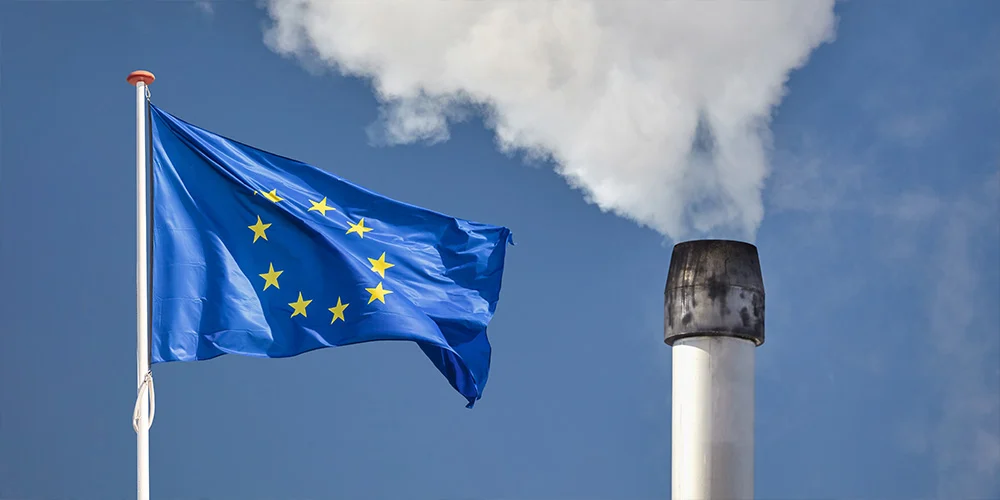
The European Union (EU) is often seen as a pioneer in implementing sustainable development policies and regulations. These policies will gradually be enforced in the future, so businesses located in other jurisdictions must closely monitor the developments of the EU's sustainable regulatory policies. This is particularly true for existing and proposed EU regulations that will affect non-EU companies, potentially posing compliance challenges for businesses outside Europe.
The Carbon Border Adjustment Mechanism (CBAM) is the latest measure under the EU's Emissions Trading System (ETS), aimed at promoting the decarbonization of EU industries. CBAM is part of the European Commission's "Fit for 55" plan, which seeks to reform the EU's ETS to achieve more ambitious carbon reduction targets.
The mechanism officially came into effect on May 17, 2023, with a transitional period from October 1, 2023, to December 2025. Under CBAM, starting January 1, 2026, EU-based importers must declare the quantity of relevant goods imported into the EU over the past year, the implied greenhouse gas emissions of these goods, and the corresponding CBAM certificate numbers.
As of August 2024, CBAM targets highly carbon-intensive industries such as cement, steel, aluminum, fertilizers, electricity, and hydrogen. By 2030, the scope of CBAM will expand to include various sectors under the EU ETS.
CBAM is expected to encourage EU importers to seek suppliers with low carbon footprints, high transparency, and traceability in their supply chains to meet the product's implied carbon emissions reporting requirements and regulatory standards. Exporters may need to bear additional costs for carbon audits to comply with the information requirements for CBAM. Once the transitional period ends and the formal implementation phase begins, exporters may have to pay additional carbon border taxes to export goods to the EU.
The EU ETS at the Core of CBAM
Established in 2005, the EU's ETS is the world's first international emissions trading system specifically designed for carbon markets. The ETS is a cap-and-trade system that sets an annual limit on greenhouse gas emissions across various sectors. This cap will gradually decrease over time to achieve climate goals, ensuring a steady reduction in emissions. Since its implementation, the EU's ETS has undergone multiple development phases, each adding more sectors and implementing stricter regulations, including the gradual phase-out of free allowances. As of 2023, carbon emissions covered by the EU ETS have been reduced by 47% since its inception.
The table below outlines the main measures of the EU ETS at different implementation stages. The EU ETS has gone through three phases since its implementation and is currently in its fourth phase, covering more high-emission industries. The fourth phase is gradually introducing CBAM and phasing out free allowances under the ETS to drive decarbonization in EU industries.
Addressing Carbon Leakage with CBAM
The EU has implemented a range of legislation as part of the "Fit for 55" package, which began in April 2023, aimed at reforming the EU's ETS to achieve broader goals. The target is to reduce the EU's net greenhouse gas emissions by at least 55% from 1990 levels by 2030 and ultimately achieve climate neutrality by 2050. Proposed by the European Commission, CBAM is one of the initiatives under "Fit for 55" to assist the ETS in addressing the issue of carbon leakage. This aims to prevent production from moving to non-EU countries (which have looser greenhouse gas emission regulations), which could lead to increased emissions, or to offset the EU's emission reduction efforts due to increased imports of carbon-intensive products.
Since the EU imposes a tax on the implied carbon content of imported products, the tax is equivalent to the EU's local carbon pricing levels. Under the new policy, importers must pay carbon costs equivalent to EU-produced goods for relevant products. This mechanism aims to prevent additional carbon costs from undermining the competitiveness of EU industries and to offset the effectiveness of the EU's greenhouse gas emission reduction measures. Moreover, by setting a charge on the implied carbon of imported goods, CBAM encourages non-EU countries to adopt clean energy for production. The ETS cap and free allowances will gradually decrease, with free allowances in regulated sectors being phased out by 2034, ensuring that emissions decline over time.
Targeting Carbon-Intensive Industry Products
As of August 2024, CBAM is directed at highly carbon-intensive industries such as cement, steel, aluminum, fertilizers, electricity, and hydrogen. Once fully implemented, over 50% of carbon emissions from sectors covered by the ETS can be captured.
The European Commission will consider expanding the regulatory scope to include other goods associated with carbon emissions, such as organic chemicals and polymers, and evaluate methods for measuring indirect emissions from products, as well as the possibility of including more downstream products after the transitional period ends. By 2030, the range of CBAM products should expand to various sectors under the EU ETS.
CBAM Transitional Period (2023 to 2025)
CBAM officially took effect on May 17, 2023, and entered its transitional period on October 1, 2023, with the first importer reporting period ending on January 31, 2024.
Before importing goods into the EU, importers must apply for CBAM-approved declarant status. They are required to report the implied emissions of imported goods for the previous quarter, including direct and indirect emissions, as well as any carbon fees paid abroad. However, during the transitional period, they are not required to purchase CBAM certificates, meaning they do not have to pay the carbon fee difference. For details on reporting requirements and calculation methods, please refer to the European Commission's website.
Authorities will first review the operation of CBAM throughout the transitional period and will only formalize its implementation after completing their assessment. They will also examine the scope of regulated products to assess the feasibility of including other industry products covered by the EU ETS in CBAM, such as certain downstream products or those deemed suitable candidates during consultations, and will publish a review report and related timeline for incorporating new products by 2030 or earlier.
Formal Implementation of CBAM (Starting in 2026)
CBAM will formally take effect on January 1, 2026. Importers will be required to declare the quantity of CBAM goods imported into the EU over the past year and the related implied greenhouse gas emissions, and then purchase the corresponding number of CBAM certificates for production activities of imported goods that have not paid carbon fees in the country of origin. The certificate price will be based on the weekly average auction price of EU ETS allowances, expressed in euros per ton of CO2 emissions. Importers who do not purchase enough certificates to offset the implied greenhouse gas emissions of their products may face penalties.
For sectors covered by CBAM, free emission allowances under the EU ETS will be gradually phased out from 2026 to 2034, over a period of nine years. As the transitional period progresses, the rate of reduction of free allowances will accelerate. The European Commission states that the goal of establishing the transitional period is to provide all stakeholders (importers, producers, and enforcement agencies) with trial experience and an adjustment period while collecting practical information about implied emissions to refine the practical implementation of the final scheme.
Impact on Hong Kong
During the current CBAM transitional period, the primary affected sectors are basic materials such as steel or cement, and there are relatively few finished or downstream products. Therefore, the initial impact of CBAM on Hong Kong is expected to be limited.
As the transitional period progresses, Hong Kong traders required to comply with CBAM are expected to provide all necessary data regarding the implied emissions of their production facilities. Exporters may need to bear additional costs for carbon audits to provide the necessary information required by CBAM. After the final scheme is implemented, they may also need to pay additional carbon border taxes to export goods to the EU.
If the scope of industries covered by CBAM expands, the impact will deepen further. On the other hand, other countries such as the United States, the United Kingdom, Canada, and Japan may follow the EU's lead and establish similar CBAM systems.
Additionally, as free emission allowances are completely phased out by 2034 and gradually reduced during the transitional period, emission costs are likely to continue to rise, further affecting the pricing of imported goods subject to CBAM.
歐盟常被視為推行可持續發展政策和規例的先驅。這些政策規例將於未來陸續實施,因此,位處其他司法管轄區的企業務必密切留意歐盟可持續監管政策的發展動向。尤其是一些現行和擬議的歐盟法規,將會影響非歐盟企業,可能對歐洲以外地區的公司帶來合規方面的挑戰。
碳邊境調節機制(CBAM)是碳排放交易系統(ETS)的最新措施,旨在推動歐盟產業去碳化。CBAM是歐盟委員會提出的「Fit for 55」的其中一項計劃旨在改革歐盟的ETS,以達致更加宏大的減碳目標。
該機制於2023年5月17日正式生效,過渡期由2023年10月1日至2025年12月。在CBAM下,自2026年1月起,以歐盟為基地的進口商必須申報過往一年進口到歐盟的相關商品數量、商品的隱含溫室氣體排放量,以及對應的CBAM憑證編號。
截至2024年8月,CBAM都是以水泥、鋼鐵、鋁、化肥、電力和氫等高度碳密集產業為目標。到 2030 年,CBAM的覆蓋範圍將擴大到歐盟ETS下的各個領域。
CBAM料可促使歐盟進口商在供應鏈物色低碳足跡、高透明度和具追溯性的供應商,以符合CBAM所規定的產品隱含碳排放通報要求和監管標準。出口商或許須承擔碳審計的額外費用,以滿足向CBAM提供所需資訊的規定。當CBAM的過渡期完結,進入正式實施階段後,出口商或許須繳納額外碳邊境稅才可對歐盟出口貨物。
歐盟ETS以CBAM為核心
歐盟的ETS於2005年設立,是全球首個專為碳市場而設的國際排放權交易系統。ETS是一個限額與交易系統,為各領域的年度溫室氣體排放總量設定上限。上限於往後時間會逐步下調以實現氣候目標,確保溫室氣體排放量逐漸減少。歐盟的ETS自實施以來已經歷了多個發展階段,每個階段都會新增更多領域,把限制溫室氣體排放的範圍擴大,並實施更嚴格的法規,包括逐步取消免費配額計劃。歐盟的ETS自2005年實施以來,所涵蓋的歐盟碳排放量至2023年已減少47%[1]。
下表概述了歐盟ETS 在不同實施階段的主要措施。歐盟ETS自實施以來已經歷了3個階段,目前處於第四階段,涵蓋更多高排放量的產業。ETS的第四階段正逐步引入CBAM,並分階段取消在ETS下的免費配額,以推動歐盟產業實現去碳化。
藉CBAM處理碳洩漏
歐盟已實施一套涵蓋不同方面的法例,自2023 年 4 月起推行「Fit for 55」一攬子政策,旨在改革歐盟的ETS,以達致更加宏大的目標。目標是到2030年歐盟溫室氣體淨排放量較1990年的水平減少至少55%,並最終在 2050 年實現氣候中和。CBAM由歐盟委員會提出,是「Fit for 55」的其中一項計劃,以協助ETS解決碳洩漏問題,以免生產線遷移到非歐盟成員國(這些國家的溫室氣體排放規定較歐盟寬鬆)後增加排放量,或因增加進口碳密集產品,令歐盟的減排措施事倍功半。
由於歐盟向進口產品的隱含碳徵收稅費,而稅費與歐盟當地碳定價水平相同。因此新政策下,進口商須就相關商品交付與歐盟製商品一致的碳成本。這項機制可以避免額外的碳成本損害歐盟產業的競爭力,以及抵銷歐盟減少溫室氣體排放措施的成效。此外,CBAM向進口商品的隱含碳設定徵費額,可以鼓勵非歐盟國家採用潔淨能源製造產品。ETS的上限和免費配額將逐步減少,受規管領域的免費配額將於2034年前逐步取消,從而確保排放量於往後日子遞減。
瞄準碳密集產業產品
截至2024年8月,CBAM都是指向水泥、鋼鐵、鋁、化肥、電力和氫等高度碳密集產業。當CBAM全面實施後,受ETS涵蓋產業逾50%的碳排放可被捕集。
歐盟委員會將考慮擴大規管範圍至涉及碳排放的其他商品,例如有機化學品和聚合物,並評估測量商品間接排放量的方法,以及在過渡期結束後納入更多下游產品的可能性。到 2030 年,CBAM 產品範圍應擴大到歐盟ETS下的各個領域。
CBAM過渡期(2023至2025年)
CBAM於2023年5月17日正式生效,並於2023年10月1日進入過渡期,首個進口商申報期已於2024年1月31日結束。
在進口商品到歐盟之前,進口商必須申請CBAM認可申報人資格。他們必須按季度申報過往一季的進口商品隱含排放量,列出直接和間接排放量以及在國外支付的任何碳費。然而,他們在過渡期內毋須購買CBAM憑證,換言之,他們毋須繳交碳費差額。有關申報要求和計算方法的詳情,請參閱歐盟委員會網站。
當局會先審視CBAM於整個過渡期內的運作情況,完成評估後才正式實施。當局也會檢視受管制產品範圍,以評估將其他涵蓋於歐盟ETS的行業產品納入CBAM的可行性,例如是某些下游產品或磋商時被視為合適的候選產品,並會在2030年或之前發布納入新產品的檢視報告與相關時間表。
CBAM正式實施(2026年起)
CBAM自2026年1月1日起正式實施,進口商須申報過往一年進口到歐盟的CBAM商品數量及相關隱含溫室氣體排放量,然後就未有在來源國繳付碳費的進口商品生產活動購買相應數量的CBAM憑證。憑證價格將以歐盟ETS配額的每周平均拍賣價格為基礎,單位為歐元/每公噸二氧化碳排放。如果進口商未有購買足夠憑證抵銷產品隱含的溫室氣體排放,則有可能會被罰款。
對於CBAM已涵蓋的行業,歐盟ETS的免費排放配額將由2026年起至2034年逐步取消,整個過渡期為期9年。隨著過渡期持續推進,免費配額的遞減速度將會逐步加快。歐盟委員會表示,設置過渡期的目標是為所有持份者(進口商、生產商及執行機關)提供試行經驗和適應期,同時收集有關隱含排放的實用資訊,以完善最終方案的實際做法。
對香港的影響
在當前的CBAM過渡期內,主要受影響的是鋼鐵或水泥等基本物料及基本物料商品,而且製成品或下游產品為數不多。因此,CBAM實施初期對香港的影響應該有限。
隨著過渡期逐步推進,須遵守CBAM要求的香港貿易商預期需要提供關於生產工場隱含排放量的所有必要數據。出口商可能需要就碳審計承擔額外成本開支,以提供CBAM所規定的必要資訊。在最終方案實施後,他們也可能須支付額外的碳邊境稅方可將商品出口到歐盟。
如果CBAM所覆蓋的行業範圍擴大,則會進一步加深影響。另一方面,美國、英國、加拿大、日本等其他國家可能也會效仿歐盟,制訂類似CBAM的制度。
此外,由於免費排放配額將於2034年完全淘汰,並且將在過渡期內逐步減少排放配額,因此排放成本很可能持續上升,進一步影響受制於CBAM的進口商品定價。
The article is sourced from Hong Kong Trade Development Council :https://research.hktdc.com/tc/article/MTgxMDQxNDI3OA




.jpg)


.jpg)
.jpg)
.jpg)







 Sign up Facebook
Sign up Facebook
 Sign up Google
Sign up Google



















